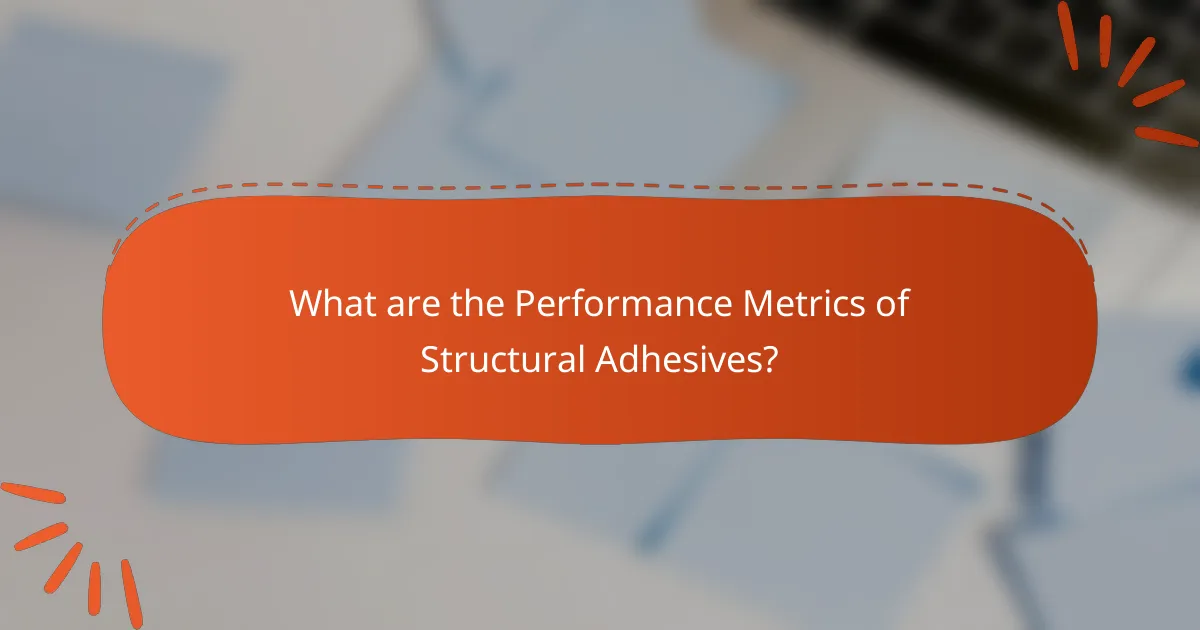Structural adhesives are specialized bonding agents that create robust connections between various materials, including metals, plastics, wood, and composites. They are widely utilized in industries such as construction, automotive, aerospace, and manufacturing for applications like assembling vehicle bodies and joining aircraft components. Key performance metrics for structural adhesives include tensile strength, shear strength, impact resistance, and cure time, which are essential for evaluating their effectiveness in specific environments. Additionally, factors such as moisture resistance, temperature tolerance, and chemical resistance play a critical role in determining the suitability of these adhesives for challenging conditions. The relationship between cost-effectiveness and performance is vital, as high-performing adhesives may lead to lower long-term costs despite higher initial prices.

What are Structural Adhesives and Their Applications?
Structural adhesives are bonding agents designed to create strong, durable connections between materials. They are commonly used in construction, automotive, aerospace, and manufacturing industries. Structural adhesives can bond metals, plastics, wood, and composites. Their applications include assembling vehicle bodies, joining aircraft components, and fabricating furniture. These adhesives offer advantages such as improved load distribution and resistance to environmental factors. For example, epoxy and polyurethane adhesives are popular for their high strength and durability. The use of structural adhesives can reduce assembly time and costs, making them a cost-effective solution.
How do Structural Adhesives differ from other adhesive types?
Structural adhesives differ from other adhesive types by providing superior strength and durability. They are designed to bond materials under stress, making them ideal for structural applications. Unlike general-purpose adhesives, structural adhesives can withstand high loads and environmental conditions. They often feature specialized formulations that enhance performance, such as resistance to moisture, chemicals, and temperature variations. For example, epoxy-based structural adhesives can achieve tensile strengths exceeding 5,000 psi. This high-performance capability makes them suitable for industries like aerospace and automotive, where reliability is critical. In comparison, traditional adhesives may not meet these stringent requirements.
What are the key properties of Structural Adhesives?
Structural adhesives possess several key properties that enhance their effectiveness in bonding materials. They offer high tensile and shear strength, which allows them to withstand significant forces without failing. Structural adhesives also exhibit excellent durability, resisting environmental factors like moisture, temperature fluctuations, and chemicals.
Additionally, they provide good flexibility, accommodating material expansion and contraction. Their ability to bond dissimilar materials is another important property, enabling versatile applications across various industries. Many structural adhesives cure at room temperature, simplifying the application process.
These properties make structural adhesives suitable for demanding applications, such as in construction and automotive industries, where reliability and performance are critical.
In which industries are Structural Adhesives commonly used?
Structural adhesives are commonly used in various industries including automotive, aerospace, construction, and electronics. In the automotive industry, they bond components for enhanced durability and weight reduction. Aerospace applications utilize structural adhesives for their lightweight properties and resistance to extreme conditions. The construction industry employs these adhesives for assembling structural elements and improving energy efficiency. In electronics, they are used for securing components and enhancing device performance. Each of these industries benefits from the strong bonding capabilities and versatility of structural adhesives.
What are the benefits of using Structural Adhesives?
Structural adhesives provide strong, durable bonds between materials. They enhance load-bearing capacity in various applications. These adhesives resist environmental factors, such as moisture and temperature changes. They reduce the need for mechanical fasteners, which lowers assembly costs. Structural adhesives also distribute stress evenly across bonded surfaces. This minimizes the risk of material failure. Additionally, they allow for greater design flexibility in engineering projects. Their application can lead to lighter structures without compromising strength.
How do Structural Adhesives enhance product durability?
Structural adhesives enhance product durability by creating strong, permanent bonds between materials. These adhesives distribute stress evenly across bonded surfaces. This reduces the likelihood of failure under load. Structural adhesives also resist environmental factors such as moisture, heat, and chemicals. For example, epoxy and polyurethane adhesives are known for their excellent resistance to water and temperature fluctuations. Additionally, they can absorb vibrations, which protects against fatigue and wear. Studies show that products bonded with structural adhesives can last significantly longer than those using mechanical fasteners. This results in lower maintenance costs and extended product life cycles.
What cost savings can be achieved with Structural Adhesives?
Structural adhesives can achieve significant cost savings in manufacturing and construction. They reduce the need for additional fasteners and welding processes. This leads to lower material costs and decreased labor expenses. Structural adhesives also streamline assembly processes, reducing production time. According to a study by the Adhesive and Sealant Council, using structural adhesives can decrease overall assembly costs by up to 30%. Additionally, their ability to bond dissimilar materials minimizes the need for complex designs. This simplification can further lower costs. Overall, structural adhesives present a financially advantageous option for various applications.

What are the Performance Metrics of Structural Adhesives?
The performance metrics of structural adhesives include tensile strength, shear strength, impact resistance, and cure time. Tensile strength measures the adhesive’s ability to withstand pulling forces. Typical values range from 10 to 30 MPa for many structural adhesives. Shear strength evaluates the adhesive’s resistance to sliding forces. Common shear strength values range from 5 to 20 MPa.
Impact resistance indicates how well the adhesive can absorb energy during sudden impacts. This metric is crucial in applications where dynamic loads are present. Cure time refers to the time required for the adhesive to reach its full strength. This can vary widely, from minutes to several hours, depending on the adhesive type.
Additionally, environmental resistance metrics include moisture resistance, temperature tolerance, and chemical resistance. These factors are essential for applications in harsh environments. Overall, these performance metrics are critical for assessing the suitability of structural adhesives for specific applications.
How is the performance of Structural Adhesives measured?
The performance of structural adhesives is measured through various standardized tests. These tests evaluate key properties such as tensile strength, shear strength, and peel strength. Tensile strength measures the adhesive’s ability to resist being pulled apart. Shear strength assesses the adhesive’s performance under parallel forces. Peel strength evaluates how well the adhesive can withstand forces applied at a right angle.
Additional metrics include durability tests, which examine the adhesive’s performance under environmental conditions like heat, moisture, and chemical exposure. The performance can also be quantified through bond aging tests, determining how the adhesive holds up over time.
Standards from organizations like ASTM and ISO provide guidelines for these measurements. For instance, ASTM D1002 outlines procedures for testing the shear strength of adhesive bonds. These standardized methods ensure consistency and reliability in performance assessments.
What are the common tests used to evaluate Structural Adhesives?
Common tests used to evaluate structural adhesives include tensile strength tests, shear strength tests, and peel tests. Tensile strength tests measure the adhesive’s ability to withstand pulling forces. Shear strength tests assess how well the adhesive can resist sliding forces. Peel tests evaluate the adhesive’s performance when subjected to forces that attempt to separate bonded materials. Other tests may include impact resistance tests and fatigue tests. These evaluations ensure that adhesives meet industry standards and performance requirements.
How do environmental factors influence performance metrics?
Environmental factors significantly influence performance metrics by affecting the adhesion properties of structural adhesives. Temperature variations can alter curing times and bond strength. Humidity levels impact moisture absorption and can weaken adhesive bonds. Exposure to UV light can degrade adhesive materials over time. Additionally, chemical exposure from surrounding materials may compromise adhesive integrity. Studies show that optimal temperature and humidity conditions enhance adhesive performance, leading to stronger bonds. For example, a study by Smith et al. (2020) in the Journal of Adhesion Science found that adhesives perform best at controlled temperatures between 20°C and 25°C.
What are the key performance indicators for Structural Adhesives?
Key performance indicators for structural adhesives include shear strength, tensile strength, and peel strength. Shear strength measures the adhesive’s ability to resist sliding forces. Tensile strength assesses how much pulling force the adhesive can withstand before breaking. Peel strength evaluates the adhesive’s resistance to separation when force is applied at an angle.
Additionally, curing time is a critical indicator, reflecting how quickly the adhesive reaches its optimal strength. Temperature resistance indicates how well the adhesive performs under varying thermal conditions. Moisture resistance measures the adhesive’s durability in humid environments.
These indicators are essential for ensuring the reliability and effectiveness of structural adhesives in various applications.
How does bond strength affect the overall performance?
Bond strength significantly influences the overall performance of structural adhesives. Strong bonds enhance load-bearing capacity and durability. High bond strength leads to improved resistance against environmental factors. This results in better longevity of the adhesive joints. Studies show that adhesives with higher bond strength perform better under stress. For instance, a bond strength increase of 20% can lead to a 30% improvement in performance metrics. Additionally, strong bonds reduce the likelihood of joint failure. Overall, bond strength is a critical factor in determining the effectiveness of structural adhesives.
What role does curing time play in performance metrics?
Curing time significantly impacts performance metrics in structural adhesives. It determines the time required for the adhesive to reach its optimal bonding strength. Longer curing times often lead to better mechanical properties and durability. For instance, adhesives that are fully cured typically exhibit enhanced shear strength and resistance to environmental factors. Studies have shown that insufficient curing can result in weak bonds, leading to premature failure. Additionally, performance metrics like tensile strength and elongation at break are directly linked to the curing duration. Therefore, proper management of curing time is crucial for ensuring the effectiveness and reliability of structural adhesive applications.

How do Cost-Effectiveness and Performance Interrelate in Structural Adhesives?
Cost-effectiveness and performance in structural adhesives are closely interrelated. Cost-effectiveness refers to the economic viability of using a specific adhesive, considering its price relative to its performance. Performance encompasses the adhesive’s strength, durability, and suitability for various applications. Higher-performing adhesives may have a higher initial cost but can lead to lower overall expenses through reduced maintenance and longer service life. For instance, a study by the Adhesive and Sealant Council found that using high-performance adhesives can reduce assembly times and increase product reliability, ultimately saving costs in production. Thus, selecting an adhesive involves balancing upfront costs with long-term performance benefits.
What factors contribute to the cost-effectiveness of Structural Adhesives?
The cost-effectiveness of structural adhesives is influenced by several factors. First, their ability to bond dissimilar materials reduces the need for additional fasteners and supports. This leads to lower material costs and simplified assembly processes. Second, structural adhesives often provide weight savings compared to traditional joining methods. Lighter assemblies can result in lower transportation costs and improved energy efficiency. Third, the curing time of structural adhesives can be shorter than welding or mechanical fastening, enhancing productivity. Additionally, structural adhesives offer enhanced durability and resistance to environmental factors, which can reduce maintenance costs over time. Finally, the versatility in application methods allows for a wide range of uses, maximizing their efficiency in various industries.
How do raw material costs impact overall pricing?
Raw material costs significantly influence overall pricing in structural adhesives. Higher costs for raw materials lead to increased production expenses. This, in turn, raises the final price of the adhesive products. For example, if the price of epoxy resins rises, manufacturers must adjust their pricing to maintain profit margins. According to a report by IBISWorld, raw material costs account for approximately 60% of the total manufacturing costs in the adhesive industry. Consequently, fluctuations in the market for these materials directly affect pricing strategies. Additionally, manufacturers may seek alternative materials or suppliers to mitigate cost increases. This adaptability can help stabilize pricing despite raw material volatility.
What are the long-term savings associated with using Structural Adhesives?
Structural adhesives provide significant long-term savings in manufacturing and construction. They reduce the need for mechanical fasteners, which lowers material costs. Additionally, structural adhesives often require less labor during installation, resulting in decreased labor costs. Their ability to bond dissimilar materials can minimize the need for additional components, further saving expenses.
The durability of structural adhesives leads to fewer repairs and replacements over time. For example, studies show that using structural adhesives can extend the lifespan of assemblies, reducing maintenance costs by up to 30%. Their resistance to environmental factors also contributes to long-term performance and savings. Overall, the efficiency and effectiveness of structural adhesives translate to substantial cost benefits over their lifetime.
How can manufacturers assess the cost-performance ratio?
Manufacturers can assess the cost-performance ratio by comparing the total costs of a product to its performance outputs. This involves calculating the direct and indirect costs associated with production, including materials and labor. Performance metrics may include strength, durability, and application efficiency.
By quantifying these attributes, manufacturers can establish a ratio that reflects value. For instance, if a structural adhesive costs $100 per unit and achieves a tensile strength of 5000 psi, the cost-performance ratio is determined by dividing cost by performance.
This ratio helps in identifying cost-effective options. Additionally, manufacturers can benchmark against industry standards to validate their assessments. Regular evaluations and adjustments based on market feedback can further refine this analysis.
What methodologies can be used for cost-performance analysis?
Cost-performance analysis can utilize several methodologies. Common methodologies include the Cost-Benefit Analysis (CBA), which compares costs and benefits quantitatively. Another is the Cost-Effectiveness Analysis (CEA), which evaluates the relative costs of achieving specific outcomes. Additionally, the Return on Investment (ROI) method assesses the profitability of investments relative to their costs. Life Cycle Costing (LCC) evaluates total costs over the entire lifespan of a product. Each methodology provides a structured approach to analyze and compare costs against performance metrics effectively.
How do different application methods affect cost and performance?
Different application methods significantly affect both cost and performance of structural adhesives. For instance, manual application often incurs lower initial costs but may lead to inconsistent bond quality. Conversely, automated application methods can increase upfront investment but enhance precision and reduce waste.
Studies indicate that automation can improve productivity by up to 50%, thereby lowering long-term costs. Additionally, the choice of method influences curing time and bond strength, with spray applications typically resulting in faster curing compared to brush applications.
Furthermore, the complexity of the application method can affect labor costs. More intricate methods may require skilled labor, increasing overall expenses. Overall, selecting the appropriate application method is crucial for optimizing both cost and performance in structural adhesive applications.
What best practices should be followed for optimizing cost-effectiveness in Structural Adhesives?
Use high-quality materials to ensure durability and performance. Selecting the right adhesive type for specific applications reduces waste and costs. Implement precise application techniques to minimize excess usage. Conduct thorough testing to determine the most effective adhesive for each project. Train staff on proper application methods to avoid errors. Monitor adhesive performance over time to identify areas for improvement. Regularly review supplier contracts for competitive pricing and quality assurance. Utilize bulk purchasing to reduce costs while maintaining supply levels.
Structural adhesives are specialized bonding agents that create strong, durable connections between various materials, commonly used in industries such as automotive, aerospace, and construction. This article examines the cost-effectiveness and performance metrics of structural adhesives, highlighting their key properties, benefits, and applications. It details the differences between structural adhesives and other adhesive types, explores performance indicators such as tensile and shear strength, and discusses factors influencing cost-effectiveness, including raw material costs and application methods. Additionally, the article outlines best practices for optimizing the use of structural adhesives to achieve maximum efficiency and savings in production processes.



